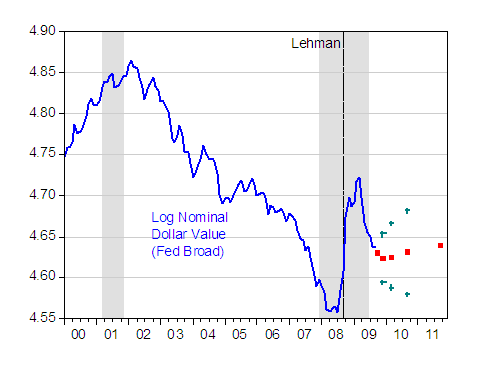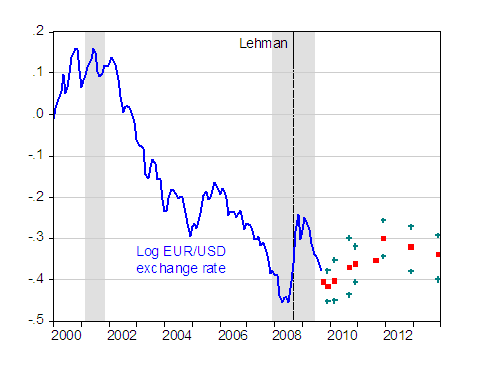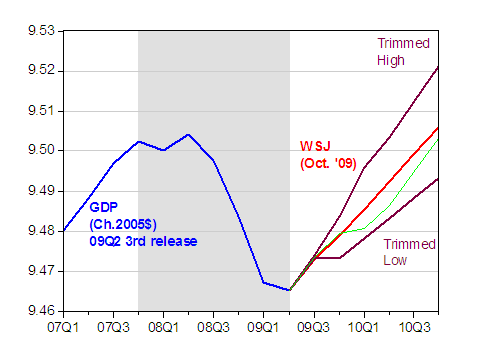I thought it of interest to see what surveys of forecasters indicate about two questions being asked: Is a dollar collapse imminent — Martin Wolf is skeptical, while others [0] are convinced the end is nigh — and is a double dip recession likely? I take a look at the messages conveyed by FX4casts.com and the WSJ October survey of forecasters.
The Dollar
First, let’s take a look at what a survey of approximately 50 banks and financial firms indicates, for the value of the dollar (Fed broad index) and the euro/dollar exchange rate.

Figure 1: Log dollar index (broad) (blue), mean forecast (red squares), high and low forecasts (95% bounds) (teal +). Forecast dates typically pertain to 4th Thursday in each month. NBER defined recessions shaded gray, assumes last recession ends 09Q2. Source: Federal Reserve via St. Louis Fed FRED II, FX4casts.com, NBER, and author’s calculations.

Figure 2: Log euro/dollar exchange rate (blue), mean forecast (red squares), high and low forecasts (95% bounds) (teal +). Forecast dates typically pertain to 4th Thursday in each month. NBER defined recessions shaded gray, assumes last recession ends 09Q2. Source: Federal Reserve via St. Louis Fed FRED II, FX4casts.com, NBER, and author’s calculations.
The data are from FX4casts, which is the successor to Currency Forecasters Digest; Jeff Frankel and I used these survey data in our studies of expectations in foreign exchange markets [1] [2] [3]. Some additional results are reported in [4] and [5].
Both series are plotted in logs, and exchange rates defined such that up implies a stronger dollar. In both cases the 95 percent interval is shown. What is clear is the (geometric) mean forecast for the dollar implies relative stability. It’s true that the lower bound implies some depreciation over the next year — but no more than 5.6 percent decline (in log terms). That’s hardly calamitous. But it would be helpful in terms of facilitating rebalancing (as I pointed out a few weeks ago [6] [7], dollar decline makes a lot of sense, perhaps even more than the 5.6 percent implied by the lower bound).
If one is more concerned about the dollar’s value against major currencies (perhaps because of an interest in cross-border valuation effects on financial assets), one would want to see how the dollar evolves against the euro. Here, it appears the mean forecst implies strength over the medium term. Even the scenario for the weakest dollar implies no more than a 7.5 percent decline, at the 3 month horizon.
More from US Treasury’s semi annual report and from Fred Bergsten in Foreign Affairs. Appendix I to the Treasury report discusses the dollar’s reserve currency status, a topic discussed in a historical perspective by myself and Jeff Frankel here and here.
Double-dip Recession?
Anxiety remains (rightly so) that the economy will suffer a relapse, with the date perhaps in 2010 or 2011. The latest WSJ survey indicates little evidence of such fears.

Figure 3: Log GDP (blue), mean WSJ forecast (red), and trimmed high (maroon) and trimmed low (maroon) forecasts, and Bart van Ark forecast (light green) based on 2009-10 growth rates. Trimming removed the top 4 and bottom 5 forecasts out of 49 responses. NBER defined recession dates shaded gray, assuming recession end is 2009Q2. Source: BEA 2009Q2 3rd release, WSJ October survey, NBER, and author’s calculations.
The mean forecast suggests a story largely consistent with last month’s forecasts. The biggest revisions (upward) came between the August and September surveys. Even then, it won’t be until close to end-2010 that GDP reattains its previous peak. Forecast dispersion remains large, though, and the trimmed high (Dean Maki, Barclays) indicates reattainment around mid-2010.
The trimmed low (David Malpass) is, interestingly, kind of a “W”, although not the typical discussed one; Malpass forecasts 0% SAAR growth in 2009Q4. Bart van Ark (Conference Board) has a drop in growth to 0.5% SAAR in 2010Q1.
Of course, these are conditional forecasts — that is they incorporate assumptions regarding a certain combination of fiscal and monetary policies. I would guess most of them are assuming “reasonable” policy mixes. But some of the recent discussions of “W” relate to mistakes in policy making, such as a too-early monetary tightening (Roubini, Krugman) or inadequate stimulus (Krugman) or the time profile of the stimulus (Feldstein).
“The latest WSJ survey indicates little evidence of such fears.”
A lack of fear might be an important gauge of psychology, but probably not of risk. Didn’t those pundits miss the recession until we were six months into it?
I think the currency forecasts look very reasonable – the speculators always seem to ignore purchasing power parity, and unless we have rather dramatic inflation, the dollar is much too low against the euro.
As for the GDP forecasts, I think they tend to be too rosy compared with what I regard as a sensible evaluation of our prospects going forward. I think this may be because they tend to rely too much on the yield curve, and that curve is not telling us the same thing as it usually does, owing to the liquidity trap. With the short rate at zero, there has virtually got to be a positive slope, no matter how small the possibility that the future short rates will rise (the tyranny of zero). This is just my old comment that econometric forecasts based on past behavior are not very useful, as we have only one pertinent observation for the current situation – GD1.
I dont get this story about dollar collapse. I live in the US / Canada border and when I compare what 100 USD buys in US as to what 100 CAD buys in Canada there is a huge difference. You can buy almost twice as much in the US, however CAD is inching up to parity where in a purchasing power basis it should be around 60 to 70 cents imho.
Who cares what forecasters think? They’re right less often than a stopped clock.
In my gastromacroeconomical opinion the recipe for a double dip recession occurs outside of the time frame being considered. The most important ingredient is that the discretionary fiscal stimulus will wind down in a big way in calendar year 2011. Based on the various forecasts this will subtract 1.5% to 2.0% from real GDP growth a quarter throughout that year. According to the Survey of Professional Forecasters unemployment will still be 8.9% and core PCE will only be 1.7%. Using Rudebusch’s estimated Taylor Rule a fed funds rate of -3.5% would be necessary indicating that monetary policy will still be essentially impotent. Add to this the likelihood by then that the commercial real estate bubble will be gathering downward momentum (producing a negative wealth effect), stir slowly over a medium boil, and voila: recession double dip d’asset bubble a la liquidity trap. Bon appetit!
joe: Most macroeconomists believe that expectations matter, regardless of whether they are correct or not. To the extent that exchange rate forecasters measure market expectations, then we should care, regardless of their accuracy.
Mark A. Sadowski: I agree that many of the scenarios point to a drop in CY2011, and I don’t think your preferred “menu” is implausible. But I think a few observers have pointed to drops even closer in, after the inventory-driven rebound in 09Q3.
Hmmm. With mortgage rates about 4%, but borrowers too underwater to refi, I think that indicates banks think we’ve hit a bottom in real estate. They believe that they can explode a bunch of borrowers and still make a ton of money on who will pay though they shouldn’t, because house prices won’t fall much more even with more forclosures and bankruptcies.
I don’t really get it. Why would some one pay 6% or more house they overpaid 30% for when they should be able to rent equivalent for way less than the interest they’re paying. Not only did they pay/borrow too much, they’re paying a 30-50% higher interest rate on that inflated balance. It doesn’t just seem rational to walk away, it looks like it’s stupid not to.
I wish these consensus forecasters the best of luck because we could all use it. But they have not seen this situation before in their regression models, and they are not considering international economic events, e.g, Spain, Eastern Europe, China’s housing bubble, etc.
There will definitely be some double dip later on (end of 2010-2011) , as history shows- if the recession is serious, double dip always comes, but not always it is as serious as in 30-ties or 80-ties to cause prolonged double recession. In 30-ties as I understand the double dip was between smaller recession and big recession.
One can look at e.g. Auruoba Diebold to see double dip in dynamics of indicators- it is ALWAYS present, but does not always qualify as recession.
The time between the process of recovery we will be seeing until February-June 2010 and the next dip is usually 1 year, closer to 1 year.
So early 2011 it is.
http://www.nypost.com/p/news/business/dollar_loses_reserve_status_to_yen_hFyfwvpBW1YYLykSJwTTEL;jsessionid=65E301CF47ED50D15170F8D6530791C5
Excerpt:
Over the last three months, banks put 63 percent of their new cash into euros and yen — not the greenbacks — a nearly complete reversal of the dollar’s onetime dominance for reserves, according to Barclays Capital. The dollar’s share of new cash in the central banks was down to 37 percent — compared with two-thirds a decade ago.
It is much less important what people think about the reserve status of the dollar compared to what is actually happening. As I have stated before the reserve status of the dollar will probably not be some sudden explosive event where the nation’s of the world suddenly make a joint announcement. The reserve status of the dollar will end with a whine and a whimper over a period of years as the world’s CBs turn to more stable currencies.
Just an aside, Menzie does not seem to be concerned over a 5.6% decline in the value of the dollar against the euro. How many of you would make an investment that lost 5.6% a year with a very good prospect of the loss increasing? Does the idea of losing 50% of your principle over 10 years thrill you? If it does then by all means invest your euros in the dollar.
RicardoZ: I think you should keep the numbers in perspective. The lower bound is 5.6% decline in log terms, by end-2009 (3 months from forecast date). That’s the floor. Then the dollar lower bound forecast implies a subsequent rebound. In any case, the standard deviation for 3 month changes in the dollar-euro exhange rate is 20.7% over the 1999M01-09M09 period. The corresponding lower bound implied change is 5.6% x 4 = 22.4%. In other words, this forecast is not terribly out of the range of experience, even assuming normality (exchange rate changes appear a bit more leptokurtic than Normal).
This is a topic haunted by hyperbole. When one writer uses “collapse” to describe the same scale of change that another writer calls “fluctuation”, their debate becomes incomprehensible.
In my mind, “collapse” is a word that implies a very big drop. Of course there’s no formal definition, but a move of less than 25% in a currency’s value is not a “collapse” in my mind.
There’s no arguing that the value of the dollar is being driven down relative to other currencies, and the values of most (maybe all) currencies are being driven down relative to assets.
But as big as all the factors are that are causing those trends, this is not what “collapse” territory looks like. It’s just not feasible for everybody to switch out of the dollar on the sort of relative scale that causes true collapses a la the ruble 1998. This recent 5% move relative to the euro is a big strain on the Eurozone economy; another 5% would be about as much as it could handle.
My economic model went negative in April 2005 indicating a recession in roughly two years (over the last 30+ years it has forecast all the recessions with a lead time of 9 to 24 months). It went back into positive territory in January of ’08 which forecast a recession lasting 22 to 24 months. While the recession took a little longer to arrive than forecast, the length looks about right. Currently the model is still high in positive territory. I think we are unlikely to see a double dip in the next 18 months or so but once the indicator starts falling I expect it to be negative in record, or near record, time. You can see the original forecast on my website’s first post in April, 2007 at http://jpetervanschaik.googlepages.com Just scroll down towards the bottom of the home page. It’s titled “Slowdown, Recession, or FULL SPEED AHEAD”